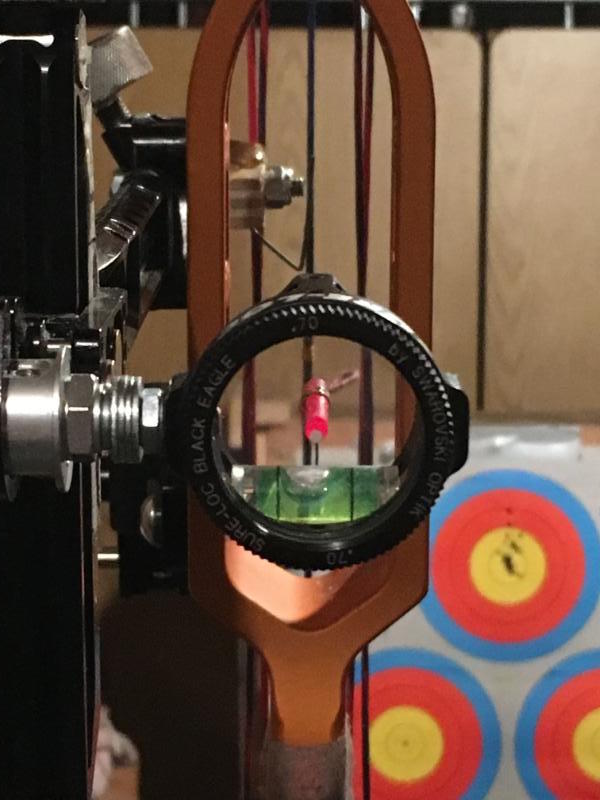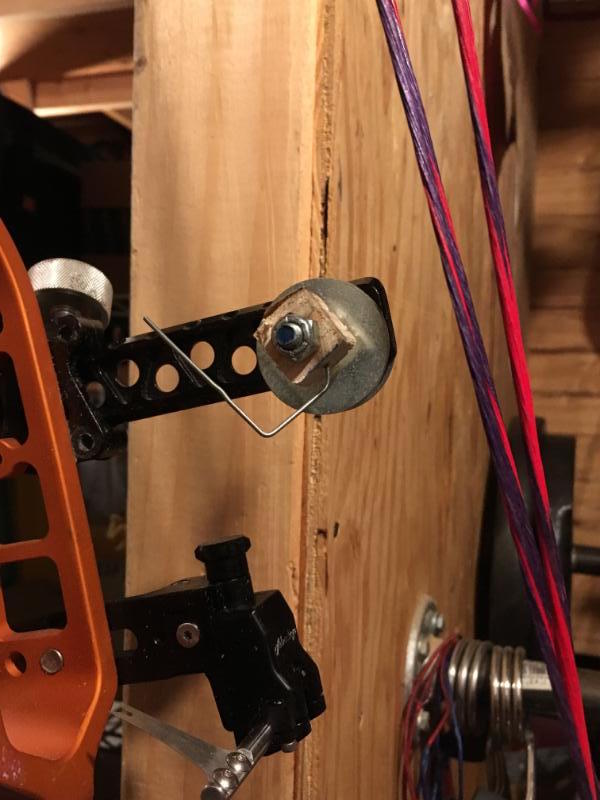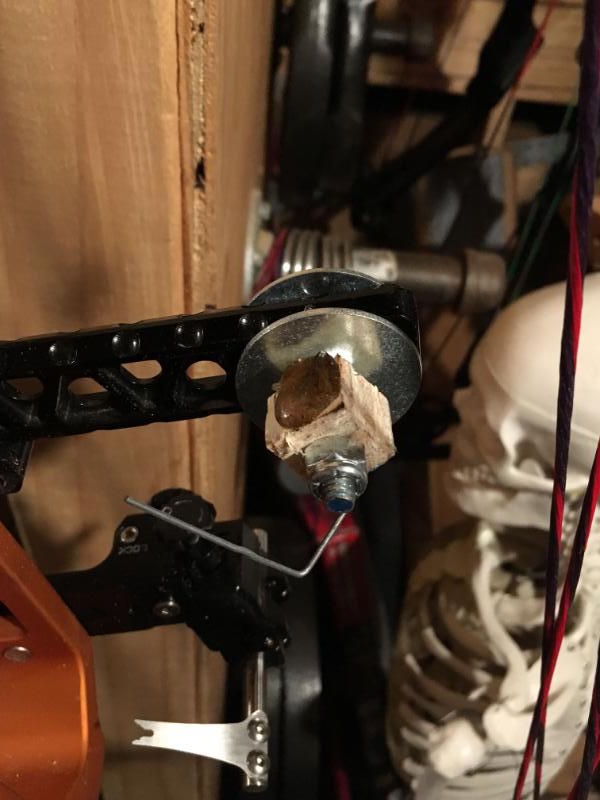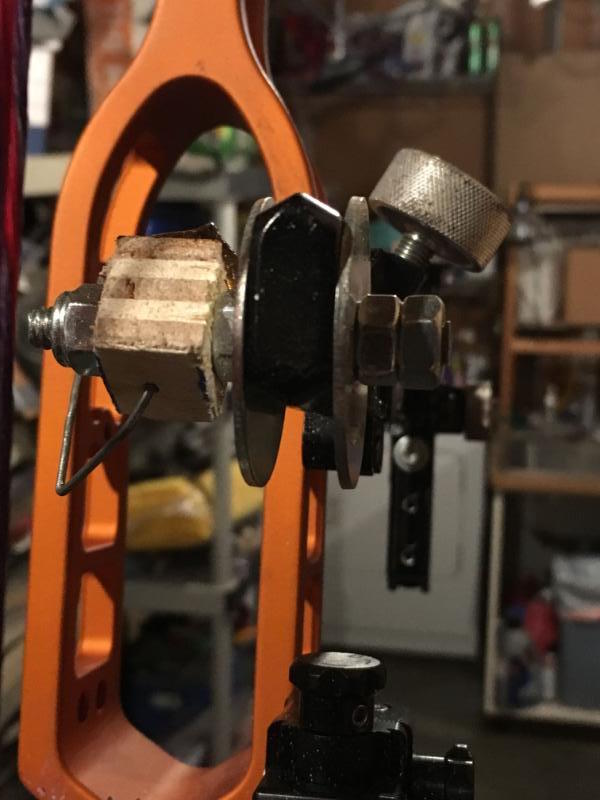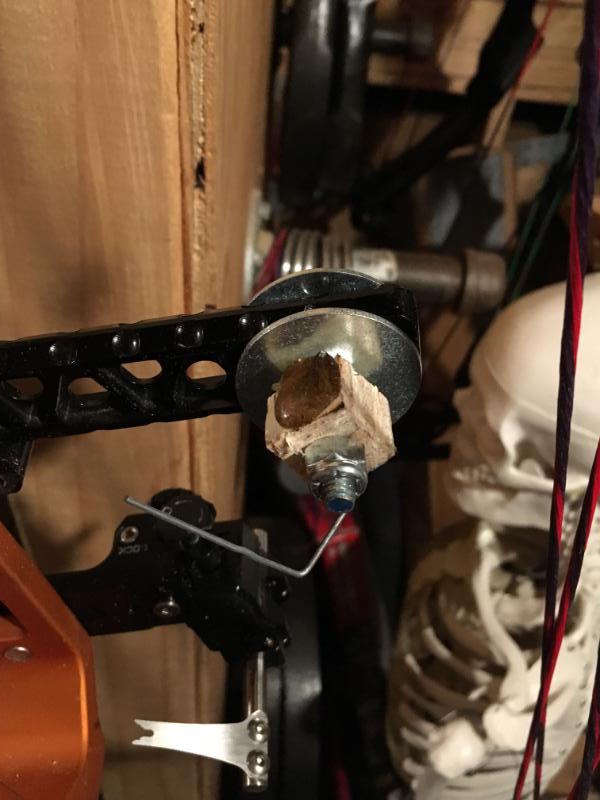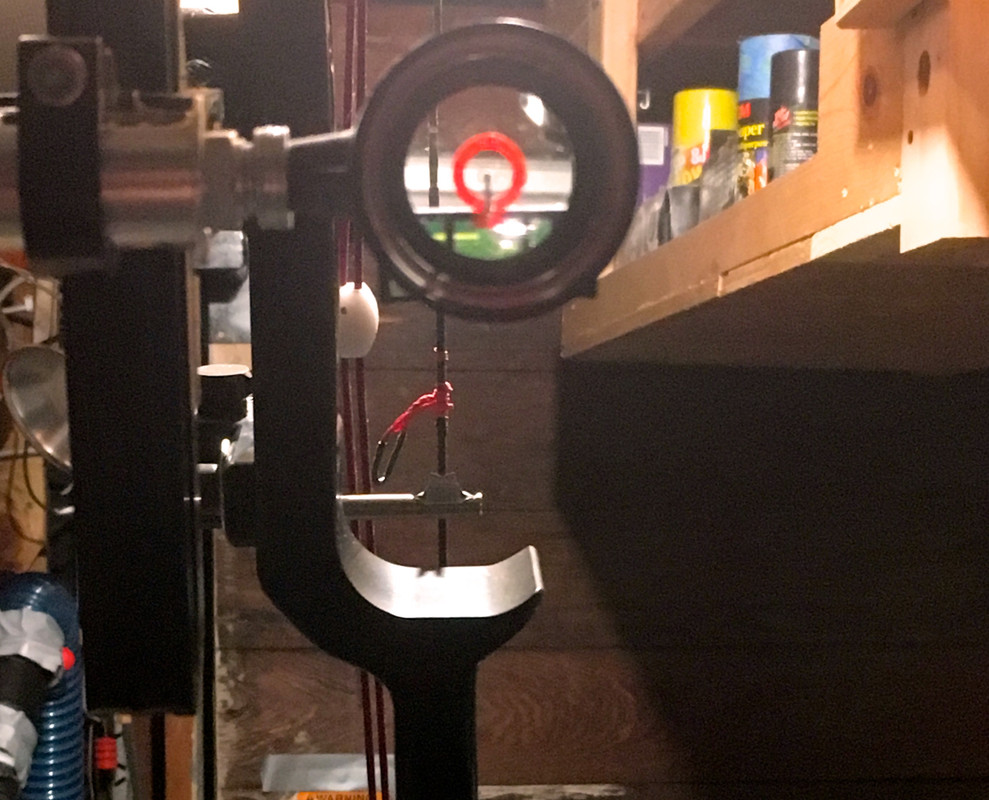I shot a bunch of 3D but 40 yard max is torque tuning worth the time? Never really done it and what yardage do ya recommend doing it at?

Is torque tuning worth it for 3D
21 - 40 of 45 Posts
Joined
·
304 Posts
IQ sight?
Joined
·
455 Posts
What if you don't have a 'Pin' but a Center-Drilled Fiber ... is the 'Torque-O-Meter' off the table ?I found the toby ragsdale video and watched it and it is a nice video showing the concept, there are so many different ways to make them. But the function is the same.
Or... Do you make a Micro "L" wire and situate it right under the fiber ??
If "Or" when's my appointment -- along with 1st/2nd/3rd Axis Leveling.
John
Joined
·
54,869 Posts
Paige Pearce and how to TORQUE TUNE the arrow rest.
She is shooting a target sight, and a long front stabilizer.
She torques the riser, so end of the long front stab swings 1-2 inches LEFT (uses wrist) and then,
swings her bow arm to re-center the scope housing in the peep.
She torques the riser, so the end of the long front stab swings 1-2 inches RIGHT (uses wrist) and then,
swings her bow arm to re-center the scope housing in the peep.
![Image]()
So, first shot, with her typical grip (no torque), the arrow hit the 10 -ring, left edge at 9-o'clock.
When Paige twisted her grip, to swing the front stab to the right, and re-centered the scope in her peep,
arrow missed right, center of 8-ring, at 3-o'clock.
When Paige twisted her grip the other direction, to swing the front stab to the left, and re-centered the scope in her peep, arrow missed left, center of 6-ring, at 9-o'clock.
Well, DUH, u say. Everybody knows if you swing the end of the long front stab to the left,
u is gonna miss LEFT. DUH.
Well, DUH, u say. Everybody knows if you swing the end of the front stab to the right,
u is gonna miss RIGHT.
So, Paige moved the arrow rest either forwards, away from face
or she moved the arrow rest backwards, closer to her face. She moved the arrow rest 3 detents...marks on the arrow rest frame.
NEW results at 50 meters (54.7 yards).
![Image]()
![Image]()
First shot no torque on the grip. Paige is at full draw for shot #2, and has torqued her grip, on purpose,
to swing the end of the long front stab about 1-inch to the right.
![Image]()
After torque tuning her arrow rest (moving the arrow rest 3 detents)..either forwards or backwards
the "torqued" arrow missed 1.25 inches to the right, hitting just outside the 10-ring, at 9-o'clock.
Prior to torque tuning her arrow rest (left target)
the two arrows are 2.5-inches apart. So, the group size cut in half, after torque tuning the arrow rest (moving arrow rest either forwards or backwards closer to face), which makes the bow much more forgiving (tighter groups, even if the grip pressure is shoving the end of the front stab sideways).
She is shooting a target sight, and a long front stabilizer.
She torques the riser, so end of the long front stab swings 1-2 inches LEFT (uses wrist) and then,
swings her bow arm to re-center the scope housing in the peep.
She torques the riser, so the end of the long front stab swings 1-2 inches RIGHT (uses wrist) and then,
swings her bow arm to re-center the scope housing in the peep.
So, first shot, with her typical grip (no torque), the arrow hit the 10 -ring, left edge at 9-o'clock.
When Paige twisted her grip, to swing the front stab to the right, and re-centered the scope in her peep,
arrow missed right, center of 8-ring, at 3-o'clock.
When Paige twisted her grip the other direction, to swing the front stab to the left, and re-centered the scope in her peep, arrow missed left, center of 6-ring, at 9-o'clock.
Well, DUH, u say. Everybody knows if you swing the end of the long front stab to the left,
u is gonna miss LEFT. DUH.
Well, DUH, u say. Everybody knows if you swing the end of the front stab to the right,
u is gonna miss RIGHT.
So, Paige moved the arrow rest either forwards, away from face
or she moved the arrow rest backwards, closer to her face. She moved the arrow rest 3 detents...marks on the arrow rest frame.
NEW results at 50 meters (54.7 yards).
First shot no torque on the grip. Paige is at full draw for shot #2, and has torqued her grip, on purpose,
to swing the end of the long front stab about 1-inch to the right.
After torque tuning her arrow rest (moving the arrow rest 3 detents)..either forwards or backwards
the "torqued" arrow missed 1.25 inches to the right, hitting just outside the 10-ring, at 9-o'clock.
Prior to torque tuning her arrow rest (left target)
the two arrows are 2.5-inches apart. So, the group size cut in half, after torque tuning the arrow rest (moving arrow rest either forwards or backwards closer to face), which makes the bow much more forgiving (tighter groups, even if the grip pressure is shoving the end of the front stab sideways).
Joined
·
54,869 Posts
Correct.The purpose of torque tuning is simply to make the setup more forgiving of the Kung Fu Grip. That's a different endeavor entirely from the purpose of a torque indicator (to tell you the mistake you're making during your shot execution and how to correct it). 2 different things.
lee.
OP asked about torque tuning. Is it worth it for 3D?
Absolutely.
Will make bow much more forgiving.
So, what's the big deal with a TORQUE indicator?
Belt and suspenders. Padgett's device/invention helps the shooter get in LINE from aiming eyeball,
to sight pin, the paper clip acts as a rear sight, to make EACH shot that much CLOSER to perfect. Allows the shooter to adjust things, to reduce any UN_INTENTIONAL torque from whatever part of the body...either unintentional torque from the bow side wrist, or the shoulders out of alignment, or too much sideways pressure into the cheek,
or tilting your head sideways. TORQUE indicator will allow the shooter to FIX this, before the arrow launches.
The TORQUE tuning, will Keep the arrows in the 12-ring, if a GUST of wind blows the end of the front stab
sideways, at the exact instant you release the arrow.
It's called BELT and SUSPENDERS. Do both.
Primary and Secondary support systems.
AFTER you torque tune the arrow rest
and you ON PURPOSE twist your wrist, and re-center the scope housing/pin guard inside your peep
and the tip of the paper clip is SCREAMING at you....youse gonna miss sideways
and you fire the shot anyways...
and the TORQUED arrow shot still hits the bullseye. EVEN with the torque indicator telling u this should NOT work.
Torque Tuning works.
It's like black magic.
Thanks! Paper clip makes more sense.U line up the tip of the paper clip, with the pin dot, the end of the fiber.
The paper clip (torque indicator) works like the rear sight on a pistol.
Your sight pin is the front sight.
I have the paper clip mounted to a wooden block. Used hot melt to lock down the paper clip.
Have wooden block on a bolt. I can turn the bolt for paper clip windage (left right adjustment).
I can rotate the wooden block to adjust elevation for the tip of the paper clip.
Line up the tip of the paper clip thru your peep, line up the tip of the paper clip with your sight pin (lollipop style)
so tip of paper clip is just UNDER the sight pin.

Joined
·
9,957 Posts
until you unwittingly bend it, or it catches on something. I would never trust an unguarded paperclip attached to the bow. I would recommend finding another implement.Thanks! Paper clip makes more sense.
My Garmin Xero A1i Pro has a reticle and red dot appears in the circle when I hold down the touch pad. if torque is applied the red dot is not inside the reticle and I see it instantly and can adjust what I'm doing wrong. Then I let off the touch pad and the target is ranged and I execute the shot. Through using this over the past 8 months I've fine tuned my shot sequence. I use the Garmin on my hunting bow, but muscle memory carries over to my other bows.
Thanks! Great info!The first time you make a torque indicator I would suggest just using a paper clip and some duck tape.
Simply open up the paper clip enough that it is going to stick out about half inch farther than your sight pins and tape it onto your riser even with the bottom mounting hole of your sight to your bow. Draw back a few times and move it up or down until it lines up with that 60 yard pin. For me using it with a single pin target sight I put it just on top of my sight bubble.
Now for the cool part, it took me years to figure this out but it makes it so much easier to adjust the indicator, Bend the wire right next to the riser and bend it back towards you like a door hinge and the wire will travel on a arc, in the beginning I made my indicator straight out and I had to peel off the tape and move it left or right and tape it back down. Now I just bend the wire on a arc until it lines up like a hinged door.
I do make a very small L shape on the end of the wire so the wire isn't pointy and this makes it easier to see along with my wife white nail polish I paint on the end.
The thing about a torque indicator is that it isn't your sight pin so it doesn't matter if it gets bent by your bow case or bumped or even ripped off, your bow is equally accurate with or without the torque indicator. So using a paper clip or thin mig welding wire has never been a issue for me other than irritating when I do accidentally bend it. When I do I either ignore it for the rest of the day or the next few times I shoot a shot if I am on level ground I bend it after the shot a few times until it is back to lining up.
If you are a strong shooter then when you are on level ground your grip of the bow is going to be spot on perfect because you have done the training to become a strong shooter. I do not ever just have random poor grip issues on level ground so my torque indicator is perfect every single shot, the torque indicator on these shots is basically ignored and not looked at even though I can see it. No, I do not have a specific look at the torque indicator time set up in my shot routine.
But
When you are on a really poor footing shot with roots and rocks and possibly a downhill shot into a valley or deep ditch this is when my red flag is on alert status when I draw the bow. Why?
Because your body is going to lie to you!!!!!! What I mean is you are going to come to anchor and settle into the shot and feel really really confident about making the shot but the moment you look through the peep you are going to see your torque indicator 1/8 inch or 1/4 inch off to the side because your body is all screwed up. Yeah, you are not standing on level ground and your feet are staggered one higher than the other and all this poor footing and downhill shot you are about to take is sending a ton of screwed up body alignment up through your legs and hips and core and shoulders and your body again is lying to you.
On these shots I let down and take a couple deep breaths and then i draw back and I twist the hell out of my bow and line up my indicator and I execute the shot and hit dead on perfect, then I stand there and watch all the other guys in the group shoot 3 or 4 inches off to the side of the 12 ring and listen to "Omg, I have my bow torque tuned so it has to be my 3rd axis that is off". I have heard that crap for pushing 10 years and that is why I simply do not waste my time with torque tuning my rest.
If you are a strong shooter then when you are on level ground your grip of the bow is going to be spot on perfect because you have done the training to become a strong shooter. I do not ever just have random poor grip issues on level ground so my torque indicator is perfect every single shot, the torque indicator on these shots is basically ignored and not looked at even though I can see it. No, I do not have a specific look at the torque indicator time set up in my shot routine.
But
When you are on a really poor footing shot with roots and rocks and possibly a downhill shot into a valley or deep ditch this is when my red flag is on alert status when I draw the bow. Why?
Because your body is going to lie to you!!!!!! What I mean is you are going to come to anchor and settle into the shot and feel really really confident about making the shot but the moment you look through the peep you are going to see your torque indicator 1/8 inch or 1/4 inch off to the side because your body is all screwed up. Yeah, you are not standing on level ground and your feet are staggered one higher than the other and all this poor footing and downhill shot you are about to take is sending a ton of screwed up body alignment up through your legs and hips and core and shoulders and your body again is lying to you.
On these shots I let down and take a couple deep breaths and then i draw back and I twist the hell out of my bow and line up my indicator and I execute the shot and hit dead on perfect, then I stand there and watch all the other guys in the group shoot 3 or 4 inches off to the side of the 12 ring and listen to "Omg, I have my bow torque tuned so it has to be my 3rd axis that is off". I have heard that crap for pushing 10 years and that is why I simply do not waste my time with torque tuning my rest.
I know that above we had Paige Pierce and her stuff shown, she is freaking awesome and one of the best shooters in the world and I am a fan. But that doesn't mean I have to fall in line and worship everything she believes in.
Me personally, I know that when I am shooting hilly outdoor 3d or field ranges my torque indicator is only going to assist me one time per scoring round normally. Have I shot 3d courses before that had multiple poor footing shots where my torque indicator helped me hell yes!!!!! But just like her last redding shoot here recently she shot near perfect score just like the men and to me having a torque indicator could have cleaned up a couple points and put her even higher and closer to that coveted perfect redding score.
People don't like it when I question our pro shooters especially Paige, I wish I was a stud pro shooter so I could but I simply am not.
Me personally, I know that when I am shooting hilly outdoor 3d or field ranges my torque indicator is only going to assist me one time per scoring round normally. Have I shot 3d courses before that had multiple poor footing shots where my torque indicator helped me hell yes!!!!! But just like her last redding shoot here recently she shot near perfect score just like the men and to me having a torque indicator could have cleaned up a couple points and put her even higher and closer to that coveted perfect redding score.
People don't like it when I question our pro shooters especially Paige, I wish I was a stud pro shooter so I could but I simply am not.
The only person who can answer the critical question for a pro such as Paige is Paige, the question is did 100 % of the shots you took in redding actually hit directly behind your pin?
That is the critical question, this weekend I shot 50 scoring shots at the tournament I attended and 100% of them hit exactly where my pin was when I fired. Now it sucks that I had some nervous energy because I have not shot a asa in a long time and my first 6 or shots friday and saturday my pin float was simply to big to be competitive at all but every single shot hit where my pin was when it fired. Now once I got over my nervous energy I hit directly in line with the 12 ring for the remaining shots I took each day and directly behind my pin.
Now the only person who knows if her missing shots at redding were directly behind her pin is Paige. If she took shots where her pin was on the orange dot and the arrow hit just off the dot then to me this concept of a torque indicator would clean it up.
That is the critical question, this weekend I shot 50 scoring shots at the tournament I attended and 100% of them hit exactly where my pin was when I fired. Now it sucks that I had some nervous energy because I have not shot a asa in a long time and my first 6 or shots friday and saturday my pin float was simply to big to be competitive at all but every single shot hit where my pin was when it fired. Now once I got over my nervous energy I hit directly in line with the 12 ring for the remaining shots I took each day and directly behind my pin.
Now the only person who knows if her missing shots at redding were directly behind her pin is Paige. If she took shots where her pin was on the orange dot and the arrow hit just off the dot then to me this concept of a torque indicator would clean it up.
The concept of forgiving is something that comes up over and over when talking about competitive archery. I do many different things to try and get my bow to be forgiving.
1. torque indicator
2. Group tuning my arrows to same hole accuracy with a hooter shooter at 20 yards
3. Sighting in my bow
4. Setting my sight needle
5. Properly tuned bow.
6. How I tie in my peep so it will not move
7. Keeping a perfect peep at full draw rotation.
8. No nock pinch or nock play, so perfect nock sets
9. 1st 2nd 3rd axis done correctly
10 stabilizers set up with a good front and rear weight combo
These are some of the things I do on my list of things to make a bow forgiving so that it does the one thing that I expect out of my bow and that is for my bow to hit directly behind the pin!!!
1. torque indicator
2. Group tuning my arrows to same hole accuracy with a hooter shooter at 20 yards
3. Sighting in my bow
4. Setting my sight needle
5. Properly tuned bow.
6. How I tie in my peep so it will not move
7. Keeping a perfect peep at full draw rotation.
8. No nock pinch or nock play, so perfect nock sets
9. 1st 2nd 3rd axis done correctly
10 stabilizers set up with a good front and rear weight combo
These are some of the things I do on my list of things to make a bow forgiving so that it does the one thing that I expect out of my bow and that is for my bow to hit directly behind the pin!!!
In my opinion, half of these things don't do anything to affect the way a bow reacts to the little inconsistencies of the shooter, which to me is the definition of forgiving.The concept of forgiving is something that comes up over and over when talking about competitive archery. I do many different things to try and get my bow to be forgiving.
1. torque indicator
2. Group tuning my arrows to same hole accuracy with a hooter shooter at 20 yards
3. Sighting in my bow
4. Setting my sight needle
5. Properly tuned bow.
6. How I tie in my peep so it will not move
7. Keeping a perfect peep at full draw rotation.
8. No nock pinch or nock play, so perfect nock sets
9. 1st 2nd 3rd axis done correctly
10 stabilizers set up with a good front and rear weight combo
These are some of the things I do on my list of things to make a bow forgiving so that it does the one thing that I expect out of my bow and that is for my bow to hit directly behind the pin!!!
I agree that they all together make a good shot, but not forgiving.
I am a little curious why you don't consider the location of the rest and/or sight when it pertains to torque as part of tuning a bow.
Good stuff, and agree... My take on the "forgiveness" concept is that it's a tough one, but like all things in archery it's a compromise. A bow & arrow is a machine, so it only reacts to what you make it do. If X always goes in, Y always comes out. And if X-prime goes in, only Y-prime comes out, every time.The concept of forgiving is something that comes up over and over when talking about competitive archery. I do many different things to try and get my bow to be forgiving.
1. torque indicator
2. Group tuning my arrows to same hole accuracy with a hooter shooter at 20 yards
3. Sighting in my bow
4. Setting my sight needle
5. Properly tuned bow.
6. How I tie in my peep so it will not move
7. Keeping a perfect peep at full draw rotation.
8. No nock pinch or nock play, so perfect nock sets
9. 1st 2nd 3rd axis done correctly
10 stabilizers set up with a good front and rear weight combo
These are some of the things I do on my list of things to make a bow forgiving so that it does the one thing that I expect out of my bow and that is for my bow to hit directly behind the pin!!!
So we have competing goals with it: we want it to do exactly what we tell it to do, when we make a good shot. But at the same time, we want it not to do exactly what we tell it to do when we make a bad shot. Obviously, we can't have both at the same time because bows just can't make decisions like that.
Meaning, a bow that really truly hits utterly behind the pin on a good shot can actually be a little too obedient. Because it will also obey very strictly when we accidentally tell it do something we didn't want it to do (hit somewhere other than the dot). This gives the vague idea of "magnifying" mistakes.
For me, this shows up as a good-shots-really-really-really-good-and-bad-shots-really-really-bad syndrome. I've not yet actually figured out exactly what makes a setup perform this way for me, but I've had bows that did this. My PSE Shootdown (may it R.I.P.) was like that, especially with a really stiff arrow. The good shots would absolutely slap each other in the X trying to dig themselves into the same hole, but even mildly bad shots often didn't even go in the gold. No matter what I did, it would really punish me hard for even the slightest mistakes.
OTOH, I've had bows that weren't obedient enough too. My Hoyt Tribute (may it R.I.P.) was like that. I could screw up really bad and the shot would be maybe still an 8/9 liner, or just barely an 8. But the good shots were lower on the 10/x count. They kind of went places that they shouldn't have even on utterly precise shots with zero mistakes.
So I kind of try to look for a happy medium, and basically an "optimal" score. I'd say my Supra RTX shooting a recurve arrow is in that range. The good shots are good enough and the bad shots aren't too bad.
Anyway, that's kind of a vague description of it all, but to me that's the general idea I have behind "forgiveness". It's not too useful, though, because it's difficult to concretely describe what gives me a "forgiving" setup and what doesn't. About half of it is good luck at stumbling on something that just shoots well for me. Like my aforementioned Supra RTX 40. A bow I actually don't particularly like, or enjoy shooting a great deal. But for some reason I shoot it better than almost anything else I've owned so far.
lee.
Joined
·
38,240 Posts
Does a torque indicator work? Yes. But I don't use one.

 www.archerytalk.com
www.archerytalk.com
Does Torque Tuning work? Yes. But I don't torque tune all my bows.

 www.archerytalk.com
www.archerytalk.com
Till G, Jesse B and Chance B torque tune....Reo Wilde said he didn't see a improvement.
Jury rigged torque indicator
Not a real fair test, but gave some indications of things. PMed with Padgett about his torque indicator. A large paper clip for the time being. Well, Padgett's riser and my riser aren't the same. I had to mount the paper clip to the front of the riser as my MX2 had deep cut outs and no real...
Does Torque Tuning work? Yes. But I don't torque tune all my bows.
Torque Tuning revisited
What bows I have set up shoot great. I can't see changing them, BUT I have a new bow in the process of setting up so it got the call. Understand, this bow is not tuned in any manner other than center shot eye balled and rest and nocking point set with levels. No back bars and only a 30"...
Till G, Jesse B and Chance B torque tune....Reo Wilde said he didn't see a improvement.
Joined
·
38,240 Posts
Chance Beaubouef; I set my hunting rest closer to the riser. Target stuff I set further back and torque tune.
////////
///////
Me, I practice First Shot Accuracy. Randy Ulmer wrote of this years ago. There is no warming up. You walk out cold and take that first shot. Say it's off. Why? Walk away and come back in hour. Take that shot again. Same results? Why? Something is off. What it is you're you and the bow ain't mated up to you. Change it. Sight? Peep? Whatever. Make a change. Take a nap, go mow the lawn. Come back and take that first shot. Improved? Walk away and try again later. Still same results? Gooder or worse? Okay, vicious circle. Keep changing until you get that first shot accuracy each and every time.....
When I go to a 3D I don't warm up. I might fling a couple shots while waiting for whoever to show up or while shooting the breeze with some one - maybe friendly competition.
C.R. got me doing this years ago. Just got the 3D and C.R. said to hurry up and come with them. I told C.R. I hadn't even warmed up. C.R. came back with; "You don't need warmed up. Come on." Off we went. I shot high overall in Adult Free Style.
////////
///////
Me, I practice First Shot Accuracy. Randy Ulmer wrote of this years ago. There is no warming up. You walk out cold and take that first shot. Say it's off. Why? Walk away and come back in hour. Take that shot again. Same results? Why? Something is off. What it is you're you and the bow ain't mated up to you. Change it. Sight? Peep? Whatever. Make a change. Take a nap, go mow the lawn. Come back and take that first shot. Improved? Walk away and try again later. Still same results? Gooder or worse? Okay, vicious circle. Keep changing until you get that first shot accuracy each and every time.....
When I go to a 3D I don't warm up. I might fling a couple shots while waiting for whoever to show up or while shooting the breeze with some one - maybe friendly competition.
C.R. got me doing this years ago. Just got the 3D and C.R. said to hurry up and come with them. I told C.R. I hadn't even warmed up. C.R. came back with; "You don't need warmed up. Come on." Off we went. I shot high overall in Adult Free Style.
Joined
·
7,654 Posts
All great information! I am def gonna tinker alittle! My peep slide down I’m gonna redo that abs be set then I’ll finish building a forgiving setup
google Hind sight
Joined
·
32,585 Posts
Depends...........if you set it up for you the torque would be compensated for in the setup process. I guess you could set it up using the same drawboard torque free method and then it would work as an indicator for sure.IQ sight?
I didn't like mine because at night when I hunt hogs the retina lock was blinding............they need to make it recessed and offer a plug for it IMO.
Joined
·
3,380 Posts
Beat me to it. I was about to post this video of Paige's.Paige Pearce and how to TORQUE TUNE the arrow rest.
She is shooting a target sight, and a long front stabilizer.
She torques the riser, so end of the long front stab swings 1-2 inches LEFT (uses wrist) and then,
swings her bow arm to re-center the scope housing in the peep.
She torques the riser, so the end of the long front stab swings 1-2 inches RIGHT (uses wrist) and then,
swings her bow arm to re-center the scope housing in the peep.
View attachment 7630186
So, first shot, with her typical grip (no torque), the arrow hit the 10 -ring, left edge at 9-o'clock.
When Paige twisted her grip, to swing the front stab to the right, and re-centered the scope in her peep,
arrow missed right, center of 8-ring, at 3-o'clock.
When Paige twisted her grip the other direction, to swing the front stab to the left, and re-centered the scope in her peep, arrow missed left, center of 6-ring, at 9-o'clock.
Well, DUH, u say. Everybody knows if you swing the end of the long front stab to the left,
u is gonna miss LEFT. DUH.
Well, DUH, u say. Everybody knows if you swing the end of the front stab to the right,
u is gonna miss RIGHT.
So, Paige moved the arrow rest either forwards, away from face
or she moved the arrow rest backwards, closer to her face. She moved the arrow rest 3 detents...marks on the arrow rest frame.
NEW results at 50 meters (54.7 yards).
View attachment 7630191
View attachment 7630193
First shot no torque on the grip. Paige is at full draw for shot #2, and has torqued her grip, on purpose,
to swing the end of the long front stab about 1-inch to the right.
View attachment 7630194
After torque tuning her arrow rest (moving the arrow rest 3 detents)..either forwards or backwards
the "torqued" arrow missed 1.25 inches to the right, hitting just outside the 10-ring, at 9-o'clock.
Prior to torque tuning her arrow rest (left target)
the two arrows are 2.5-inches apart. So, the group size cut in half, after torque tuning the arrow rest (moving arrow rest either forwards or backwards closer to face), which makes the bow much more forgiving (tighter groups, even if the grip pressure is shoving the end of the front stab sideways).
Because all the people i know who torque tune still have fliers 3 inches left or right.In my opinion, half of these things don't do anything to affect the way a bow reacts to the little inconsistencies of the shooter, which to me is the definition of forgiving.
I agree that they all together make a good shot, but not forgiving.
I am a little curious why you don't consider the location of the rest and/or sight when it pertains to torque as part of tuning a bow.
21 - 40 of 45 Posts
-
?
-
?
-
?
-
?
-
?
-
?
-
?
-
?
-
?
-
?
-
?
-
?
-
?
-
?
-
?
-
?
-
?
-
?
-
?
-
?
- posts
- 39M
- members
- 241K
- Since
- 2001
A forum community dedicated to bow and crossbow owners and archery enthusiasts. Come join the discussion about optics, hunting, performance, troubleshooting, styles, reviews, accessories, classifieds, and more!
Top Contributors this Month
View All
Arrowbender
1.2K Replies
Mossy-Back
660 Replies
toddcbrown
598 Replies

